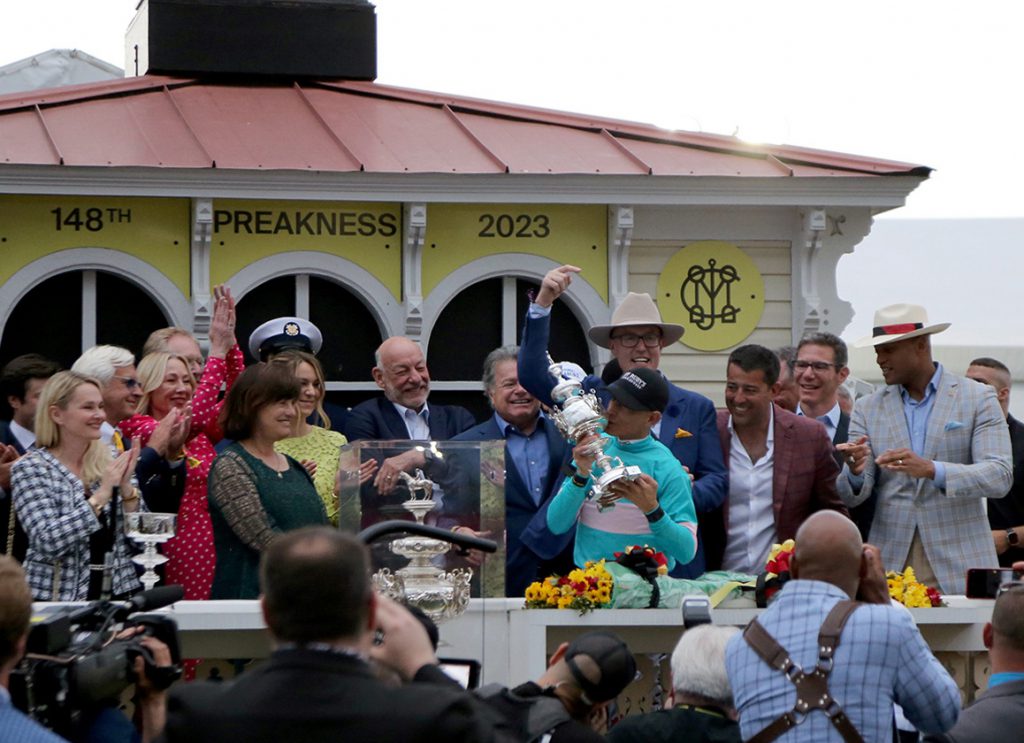The hearing officer assigned to oversee trainer Bob Baffert and owner Zedan Racing Stables' appeal of penalties related to the drug disqualification of 2021 GI Kentucky Derby winner Medina Spirit (Protonico) has issued a recommended order to the Kentucky Horse Racing Commission (KHRC) that the underlying stewards' rulings be affirmed in their entirety.
The 47-page report was made public via press release by the Kentucky Public Protection Cabinet early on the Friday evening of the long Memorial Day holiday weekend. Its issuance comes 765 days after Medina Spirit crossed the finish wire first in the 147th Derby but subsequently tested positive for betamethasone in a KHRC post-race drug screening.
The recommendation, which must be considered and voted upon by the full KHRC board at a later date, upholds Medina Spirit's DQ, a 90-day suspension that Baffert has already served but wanted expunged from his record, and a $7,500 fine imposed upon the Hall-of-Fame trainer. Acceptance of the report's findings by the KHRC would affirm Mandaloun (Into Mischief) as the official winner of the 2021 Derby.
“The Hearing Officer finds and concludes that the KHRC has shown that the stewards' decision was made on reliable, substantive evidence that the horse, Medina Spirit, was administered and carried the prohibited substance, betamethasone,” hearing officer Eden Stephens wrote.
“The plain language of the KHRC's betamethasone regulations is clear: betamethasone is prohibited in a post-race sample,” Stephens wrote.
The debate over whether or not Medina Spirit's betamethasone finding was the result of an injection or the application of an ointment to treat a skin condition had been a focal point of testimony during six days of appeal hearings in August 2022.
“Parties agree the KHRC has the burden of proof but differ framing the question of what needs to be proven,” Stephens wrote. “KHRC argues it must establish a prima facie case that Medina Spirit [tested positive for a prohibited drug]. Appellants believe this case is solely premised on whether the use of a topical ointment, Otomax, for a clinically diagnosed skin infection on a racehorse, constitutes a violation of any clearly expressed and unambiguous rule…” Stephens wrote.
“At the running of the 147th Kentucky Derby on May 1, 2021, no KHRC regulation set forth an 'established concentration level' under which betamethasone is allowed in a post-race sample. Therefore, a laboratory finding of betamethasone in a post-race sample establishes a prima facie case that a trainer violated the KHRC's medication regulations,” Stephens wrote.
“Appellants contend that 810 KAR 8:010 Section 4 permits the administration of betamethasone ointment; therefore, a betamethasone positive arising due to an ointment administration is not a violation. This interpretation improperly conflates the KHRC's regulations governing medication administration with the regulations governing medication levels in post-race samples,” Stephens wrote.
“The KHRC's regulations do not state that any route of administration excuses a post-race betamethasone positive,” Stephens wrote.
“Additionally, the KHRC has a longstanding, uninterrupted history of treating all medications without thresholds as limit-of-detection medications and of finding that the administration route leading to a medication positive is irrelevant,” Stephens wrote.
“Betamethasone is a Class C drug. Its presence in a horse's post-race sample is prohibited by the KHRC, regardless of method of administration. Betamethasone has the potential to influence performance, as well as health and safety, in equine athletes,” Stephens wrote.
“Finally, the Stewards' Rulings in this case were restrained and reasonable. The stewards could have imposed a five-year suspension and $50,000 fine. Instead, they suspended Mr. Baffert for 90 days and fined him $7,500,” Stephens wrote.
The press release outlined the next steps in the process.
“Both parties can file exceptions to the recommended order should either party believe the hearing officer made an incorrect finding of fact or conclusion of law. The matter will then be referred to the KHRC to issue a Final Order,” the release stated.
“A Final Order may be appealed to Circuit Court within 30 days of issuance of the Final Order. If no appeal is filed within 30 days, the case will end,” the release stated.
A Saturday morning voicemail message seeking comment from Baffert's attorney, Clark Brewster, did not yield a reply prior to deadline for this story.
The post Hearing Officer Affirms Medina Spirit Derby DQ And Baffert Penalties appeared first on TDN | Thoroughbred Daily News | Horse Racing News, Results and Video | Thoroughbred Breeding and Auctions.


